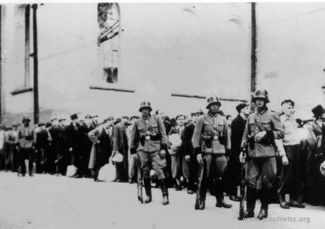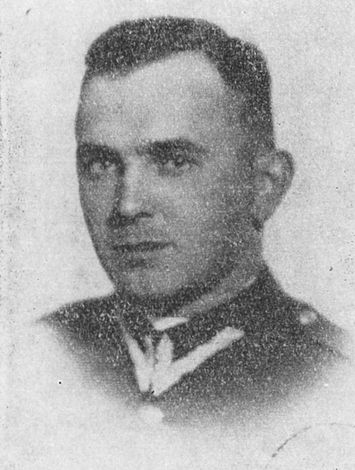Author
Stanisław Kłodzinski, MD, 1918–1990, lung specialist, Department of Pneumology, Academy of Medicine in Kraków. Co-editor of Przegląd Lekarski – Oświęcim. Former prisoner of the Auschwitz‑Birkenau concentration camp, prisoner No. 20019. Wikipedia article in English.
Many Poles, including physicians, considered Poland’s defence in September 1939, when the country was invaded by Nazi Germany, as just the first phase in their struggle against the Third Reich. When the Polish Army stopped regular military operations, many officers and rank-and-file soldiers still wanted to engage in combat on Polish territory or to join the newly formed Polish troops abroad, so for instance they fled to France via Hungary. However, the journey was risky. Those who were captured by the Germans were either killed or deported to jails and concentration camps. Dr Edward Nowak was one of these prisoners.
He was born on 25 September 1909 at Rytro in the region of Nowy Sącz as the eldest son of Józef and Maria Nowak. After three years of primary education in his native village, he completed his fourth year in Stary Sącz. He started secondary school in Nowy Sącz, but passed his final exams in 1928 in Stanisławów.1 Even as a boy, he was quiet and an avid reader. He enjoyed swimming, and skiing was his favourite winter pastime.
On leaving school, he completed his national service in a machine gun company in the reserve officers’ training academy in Kraków. He took a competitive entrance examination for the Warsaw military medical college2 and automatically became a student at the Faculty of Medicine at the University of Warsaw. The military medical college required its students to wear a uniform and to take part in additional military training. It provided accommodation and full board. All the tests and examinations had the same format as those administered to “civilian” students.
Edward Nowak was a student from 1930 to 1936. He was gifted, hard-working, and reserved, neither a ladies’ man, nor a bon vivant. Having completed his studies, he worked as an intern in Warsaw, was promoted to second lieutenant and posted to Wilno,3 with a commission in the First Infantry Regiment of the Legions.4 Upon arrival in Wilno, he was appointed junior regimental physician. During his service, he acquired the reputation of an excellent officer and medic. Although at first he had little experience in either capacity, he was very conscientious, disciplined, and had a sense of duty, and so, according to the regimental mobilization plan, was to become senior regimental physician.
During the September ’39 campaign, the First Infantry Regiment was part of the First Division of the Legions and belonged to the Wyszków Operational Group,5 the Chief Commander’s military reserve. On mobilization, the regiment was relocated by train and deployed in the concentration area between Ostrów Mazowiecka and Długosiodło. Dr Nowak worked as senior regimental physician. The concentration was over by 2 September 1939. The regiment engaged in combat at Różan, Pułtusk, Wyszków, Kałuszyn, Lipiny, Trzciniec, and Jagodne. On 14 September 1939, the division was encircled by German troops near Stoczek and Łuków and defeated after heavy fighting.
As regimental physician, Dr Nowak must have found it difficult to work under constant stress, while the troops were continually engaged in combat or being moved to new locations. They were under massive Luftwaffe attack, which made it impossible to plan any routine medical procedures. The division had not built a field hospital by the time the defensive campaign was over, and the sick and wounded were transported to local civilian hospitals. In the final days of the campaign, even the most rudimentary medicines and dressings were in short supply.
In the face of escalating difficulties, Dr Nowak proved exceptionally resourceful whenever he had to provide impromptu medical assistance quickly and efficiently. Actually, he did more than work as the regimental physician: on the night of 14–15 September 1939, he and a few other officers broke out of the encirclement in order to continue fighting. Those lucky enough to get away eastwards, to the area of Białowieża Forest, formed a battalion called Biała commanded by Lt. Bogusław Cereniewicz. Dr Nowak served as battalion physician, supervising a few other doctors and about twenty women nurses and medics. In late September 1939, Biała joined the Polesie Independent Operational Group, whose commander-in-chief was Brig. Gen. Franciszek Kleeberg, and was renamed the Third Battalion of the 178th Infantry Regiment, under the command of Col. Ottokar Brzoza-Brzezina. Dr Nowak’s unit took part in all the operations of Kleeberg’s group until 6 October 1939, when the Polish Army capitulated. Polesie was the last Polish tactical unit to fight the German invaders.6 Lt. Cereniewicz said that in that dramatic period, Dr Nowak not only carried out his usual, heavy duties as a doctor, but also joined regular combat like any frontline officer, weapon in hand.
On 6 October 1939 Dr Nowak was taken prisoner by the Germans and transferred to a POW transit camp in Radom, where he was detained until 19 October. Then he was moved to a similar camp on ul. Prosta in Kielce, where he was to look after sick POWs. On 13 December 1939 that camp was closed down: the men were released while the officers were deported to oflags in the Third Reich. As a doctor, Nowak was discharged and returned to his family home in Rytro. Like a true soldier, he immediately tried to leave the territory of Poland and join the Polish Army that was being formed in Western Europe.

Polish political prisoners in Tarnów awaiting the transport to Auschwitz. Source: Archives of the Auschwitz-Birkenau State Museum. Click the image to enlarge.
Although Dr Nowak’s parents begged him to stay at home, he considered himself not only a physician, but above all an officer, and therefore decided otherwise. On 27 March 1940 he made an attempt to cross the border with Slovakia for Hungary, but was captured by the Slovaks and handed over to the Gestapo. He was detained at Muszyna and later in Nowy Sącz. He was brutally tortured and his family received his bloodstained civilian clothes—irrefutable proof of the violence he had suffered. From Nowy Sącz, Dr Nowak was transferred to Tarnów, where, on 14 June 1940, he was put on the first transport of Polish prisoners to Auschwitz. In the camp he was registered as No. 447.
Dr Nowak was one of the first Polish physicians employed in the prisoners’ hospital in Auschwitz. He was noted for his kindness, diligence, humility, and reliability, and known as a good specialist and trustworthy colleague. Through lack of pharmaceuticals and instruments, camp medicine amounted to basic care-giving, but sometimes the only treatment was a word of consolation. Dr Nowak supervised two difficult wards, for those who suffered from starvation diarrhoea (Durchfall) and, periodically, for those afflicted with scabies (Krätze). As a hard-working man, he earned the respect of his patients, fellow doctors and orderlies. He was reticent, withdrawn, dedicated to his work, careful, and poised, usually deep in thought. He never talked about himself, his own war experiences, his attempted escape, or the events that preceded his confinement in the camp.
Dr Nowak never hesitated to risk his own life if an inmate needed help, especially if his life was in danger. Many survivors are aware of the fact that they owe their lives to him. Dr Nowak procured medicines by any means he could contrive, and when he was helpless and could not cheat death, he made the patients’ last moments easier by staying by their side and bringing them peace of mind. When it was necessary, his scabies ward illicitly took in prisoners with pneumonia, tuberculosis or other problems. Dr Nowak also looked after convalescents. Using his network of personal contacts, he made sure that his patients, who were usually discharged when they had not fully recovered, were assigned light jobs, so as not to exert themselves. For instance, they could peel potatoes or other vegetables, or work in the basket-weavers’ or stocking-darners’ unit. For some time, the convalescents had a sanctuary in the plucking unit, providing goose down for SS men’s pillows. As Dr Nowak had friends in every section of the camp, he found suitable Kommandos for his “protégés.”
One of Dr Nowak’s co-workers in Block 15 (which was later called Block 20), that is in the prisoners’ hospital, was a young priest, Konrad Szweda, No. 7669. Father Szweda was assigned the job of a Hilfspfleger (assistant orderly). In his recollections of the camp, he wrote,
I was impressed by Dr Edward Nowak’s conduct, full of dedication and commitment to his work. In those horrible, inhuman conditions, he wanted to help sick people, alleviate their suffering, and ease their pain. Though he had neither medications nor sterile instruments, his smiling face and kind words brought hope to the downhearted. Prisoners respected him and orderlies sought his advice.
I remember him performing the following procedure: Wilhelm Koloch from Lipiny, who had arrived in the camp on the same transport as myself, had his pleural cavity punctured. A litre of pus was extracted. This assuaged Wilhelm’s suffering, but unfortunately he developed an infection and died, just like many other patients. . . . Dr Nowak was crestfallen when his patients were selected7 or deported. He was right to assume that the sick were not taken to a “sanatorium,” as they were informed, but to the crematorium. In early September 1941 the prisoners’ hospital witnessed one of these selections: five patients from Dr Nowak’s ward were selected. The selection was performed by an SS board headed by the Lagerarzt.8 I was not in the ward during that official visit. Dr Nowak was very worried about the selected patients and expected something bad would happen to them. He explained to his closest friends that only one of them was past recovery, while the others could still tough it out. Unfortunately, the doctor’s worst fears came true: all the selected patients were thrown into the bunkers of Death Block (which was initially numbered Block 13, and later Block 11) and gassed. When Dr Nowak learned that the sick men had been piled up for the lethal procedure while still alive, body upon body, he trembled with terror and dismay: “I don’t want to be in Auschwitz! I want to save people, not put them to death!” In the darkness of the concentration camp, he was our ray of hope. He was a person of principle in a place which dehumanized people, stripped them of their dignity, and utterly depraved them. Modest and unprepossessing, he did not hold a high opinion of himself. He viewed medical practice not as a profession, but a vocation and faithful service to the community.
Konrad Szweda, Letter of 7 April 1970
In November 1941, Hans Böck, No. 5, the Lagerälteste (block elder of the prisoners’ hospital) was ordered to find a few volunteers from the prisoner doctors to be transferred to a newly established concentration camp. At that time no-one knew it was Majdanek near Lublin. The volunteers were Edward Nowak, Jan Nowak, Henryk Suchnicki, Władysław Tondos, Stanisław Wrona-Merski, and Romuald Sztaba. This group had to spend two months in “quarantine” before departure, on the upper floor of Block 13, above the quarters of the penal unit. Eventually only four of the prisoner doctors, Edward Nowak, No. 447; Jan Nowak, No. 17380; Stanisław Wrona-Merski, No. 13842; and Romuald Sztaba, No. 10997, were transferred to Majdanek, but not until 18 February 1942. The others returned to work in the prisoners’ hospital in Auschwitz. The four transferred physicians travelled to Lublin by train, in their civilian clothes, under escort. In Majdanek, they met several physicians who had arrived earlier from other concentration camps.
Dr Edward Nowak did not change in the new, equally difficult milieu. He continued his inconspicuous, dedicated effort and was as modest as ever. All the prisoner doctors lived in the same room, so they could spend their evenings talking to one another. However, Nowak was one of the least talkative and tended to keep himself to himself, not even mentioning his time at university. He was meticulous about the camp chores, such as making his bed, washing up the dishes, and cleaning his shoes, and never asked for help. He was self-reliant, but always glad to help whenever somebody needed a favour.
Within a few weeks of arriving in the new camp, all the prisoner doctors who had not contracted typhus previously fell ill. Dr Edward Nowak did not have typhus in Auschwitz and was one of the last to develop it in Majdanek. The place was literally lice-ridden and the epidemic did not look like subsiding for a long time. By the time Nowak’s colleagues had all recovered from typhus, he had still not contracted it. Inmates joked that lice didn’t take to Dr Nowak.
So it came as a surprise when in late autumn 1942 Dr Edward Nowak ran a fever and was soon diagnosed with typhus. He was admitted to the hospital and put under the care of his friend, Dr Jan Nowak. Nowak the patient was quite well provided for (by concentration camp standards). His roommate was Dr Romuald Sztaba, who was convalescing. For Edward Nowak, the first days of his illness were not difficult. He became unusually talkative when he developed a fever. He described many events from his life in Wilno and enjoyed reminiscing about his days as a regimental physician. He hoped his illness would take a mild course and expected to recover. Realizing conditions in Majdanek were better, he compared them to the realities of Auschwitz. He stressed that during the last months of the typhus epidemic the death rate had been low. He was neither anxious nor panicky, even though he was getting worse day by day.
Around the tenth day of his illness, Dr Edward Nowak lost consciousness, becoming oblivious to the world around him. Shortly afterwards he developed cerebral symptoms, and had tonic spasms of the limbs and mandible as well as breathing difficulties. No crisis was observed, which should have come on the twelfth or thirteenth day. He also had a raging fever. Dr Jan Nowak and the other physicians used all the available means to save him, but intravenously administered saline solutions and glucose proved of no avail. Finally, on the fourteenth day, Dr Edward Nowak died of cerebral complications. His body was carried to the camp crematorium by his colleagues, who wanted to pay their last respects in this way. The Gestapo in Nowy Sącz notified Dr Nowak’s family of his decease, giving 24 December 1942 as the date of death. His personal belongings were returned to his relatives on 9 January 1943.
In 1946 Dr Nowak’s father, who was 73 at the time, made an irrevocable decision: he wanted to go to Majdanek to see where his son had died. He returned from the expedition a broken man.
In recognition of his valour and military prowess in September 1939, Second Lieutenant Dr Edward Nowak received the Cross of Valour9 (No. 33776).
The tragic story of Dr Edward Nowak closely resembles the lives of many other young Polish doctors remembered by their wartime friends who survived the war. When gathering materials for this paper about Dr Edward Nowak, I had the impression that hundreds of Polish Nowaks, whose biographies can no longer be reconstructed, suffered an almost identical fate.
***
To prepare this paper, I used the following sources: (1) documents and information in possession of Dr Nowak’s family, to which I was given access by his brother, Józef Nowak; (2) information provided by Tadeusz Iwaszko, head of the archives of the Auschwitz-Birkenau State Museum; (3) entries in the Auschwitz timeline compiled by Danuta Czech10 and published in Zeszyty Oświęcimskie 1958 (3), p. 63; (4) extensive accounts sent by several people, to whom I am deeply grateful: Bogusław Cereniewicz (author of Wrześniowe drogi [September routes], Warszawa: Pax, 1958), Dr Tadeusz Paczuła, Dr Adam Proń, Dr Stanisław Suliborski, Kazimierz Szczerbowski, Prof. Romuald Sztaba (author of the article “O niektórych więźniach Majdanka” [Some Majdanek prisoners] published in Przegląd Lekarski — Oświęcim 1969 (1), p. 173), and Father Konrad Szweda; (5) my own recollections of the camp.***
Translated from original article: Kłodziński, S. Dr Edward Nowak (więzień obozu oświęcimskiego nr 447). Przegląd Lekarski – Oświęcim, 1971.
Notes
- Now Ivano-Frankivsk, Ukraine.
- Centrum Wyszkolenia Sanitarnego w Warszawie.
- Now Vilnius, Lithuania.
- 1 Pułk Piechoty Legionów.
- Grupa Operacyjna „Wyszków.” Operational groups were a type of unit specific for the Polish Army, generally deployed for tactical purposes.
- At one point, Kleeberg’s troops were fighting both the Germans and Soviet forces, which had invaded Poland on 17 September, but of course under the People’s Republic this fact could not be published for censorship reasons. Cf. https://dzieje.pl/postacie/franciszek-kleeberg.
- In the German concentration camps “selection” meant that the selected prisoner was shortlisted for death, usually in the gas chamber, or killed with a lethal injection.
- Here the term Lagerarzt means the chief SS physician for the camp.
- Krzyż Walecznych.
- Original Polish edition: Kalendarz wydarzeń obozowych; English edition (1999), Auschwitz Chronicle, 1939-1945.
Notes by Teresa Bałuk-Ulewiczowa, Head Translator for the Medical Review Auschwitz project.


A publication funded in 2020–2021 within the DIALOG Program of the Ministry of Science and Higher Education in Poland.



